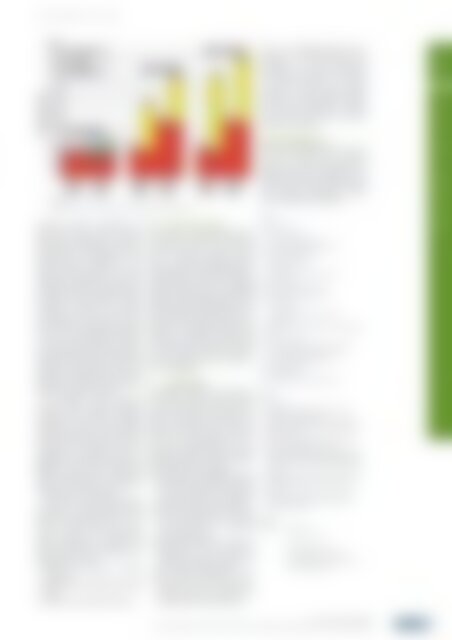atw - International Journal for Nuclear Power | 05.2020
Description Ever since its first issue in 1956, the atw – International Journal for Nuclear Power has been a publisher of specialist articles, background reports, interviews and news about developments and trends from all important sectors of nuclear energy, nuclear technology and the energy industry. Internationally current and competent, the professional journal atw is a valuable source of information. www.nucmag.com
Description
Ever since its first issue in 1956, the atw – International Journal for Nuclear Power has been a publisher of specialist articles, background reports, interviews and news about developments and trends from all important sectors of nuclear energy, nuclear technology and the energy industry. Internationally current and competent, the professional journal atw is a valuable source of information.
www.nucmag.com
You also want an ePaper? Increase the reach of your titles
YUMPU automatically turns print PDFs into web optimized ePapers that Google loves.
<strong>atw</strong> Vol. 65 (2020) | Issue 5 ı May<br />
| Fig. 3.<br />
Comparison of the chemical precipitates with various plant environments.<br />
aluminum silicate precipitates because<br />
long spray time increases<br />
dissolution of aluminum as well as<br />
silicon. The precipitation of aluminum<br />
oxy hydroxide is negligible in the<br />
present analysis because the concentration<br />
of aluminum is not sufficiently<br />
lager than that of silicon. The<br />
quantity of sodium aluminum silicate<br />
is limited by the amount of silicon<br />
available in solution, if the silicon<br />
concentration is less than 3.12 times<br />
the aluminum concentration as shown<br />
in Eq. (7). Any remaining aluminum<br />
in solution will precipitate as aluminum<br />
oxyhyroxide. If the concentration<br />
of silicon is greater than 3.12 times the<br />
aluminum concentration, then the<br />
quantity of sodium aluminum silicate<br />
generated is limited by the concentration<br />
of aluminum available.<br />
For plants using trisodium<br />
phosphate (TSP), calcium phosphate<br />
is generated in addition to sodium<br />
aluminum silicate and aluminum<br />
oxyhydroxide. When CalSil and TSP<br />
co-exist, significant amount of calcium<br />
phosphate is generated with increasing<br />
amount of Cal-Sil as shown in<br />
Figure 3. It has been known that<br />
calcium phosphate has a significant<br />
impact on the head loss because its<br />
characteristics are like a gum.<br />
There<strong>for</strong>e, above-mentioned three<br />
parameters, i.e., the amount of Cal-Sil,<br />
long spray termination time, use of<br />
TSP as a buffer agent has a most<br />
negative effect on the recirculation<br />
sump per<strong>for</strong>mance. Through the<br />
present study, the following recommendations<br />
are made:<br />
(a) Reduce the amount of Cal-Sil<br />
insulation<br />
(b) Replace TSP with alternate buffer<br />
agent<br />
(c) Reduce spray time by operation<br />
3.3 Debris interceptor<br />
There may be various design options<br />
to reduce the head loss across the<br />
sump screen such as an active strainer<br />
and a specially designed screen<br />
surface to prevent the thin bed effects.<br />
The adoption of a debris interceptor is<br />
another viable option <strong>for</strong> reducing<br />
particulate debris such as unqualified<br />
coatings. The detailed effects on the<br />
debris transport are dependent on the<br />
specific debris interceptor design. For<br />
example, if the debris interceptor can<br />
reduce the particulate debris from<br />
3,000 lbm to 1,000 lbm, the head loss<br />
can be reduced <strong>for</strong>m 3.98 ft to 0.87 ft<br />
<strong>for</strong> 400 ft 3 fiber debris loading as<br />
shown in Figure 1.<br />
4 Conclusions<br />
A parametric study is per<strong>for</strong>med on<br />
the effects of debris source, containment<br />
environments and debris interceptor<br />
on the overall per<strong>for</strong>mance of<br />
ECCS recirculation sump. The key<br />
parameters of each effect are deduced<br />
and the recommendations <strong>for</strong> reducing<br />
their adverse effects are made<br />
through the present ana lysis. Following<br />
conclusions can be made:<br />
(a) The amount of unqualified coating<br />
debris has a great adverse effect on<br />
the screen head loss by reducing<br />
porosity in the fibrous insulation,<br />
(b) Cal-Sil insulation reacts with TSP<br />
buffer and significantly increases<br />
the generation of a gum-like<br />
chemical precipitate,<br />
(c) Spray time increases the chemical<br />
by-products but the effect is<br />
smaller than that of buffer agent<br />
type and unqualified coating.<br />
(d) The debris interceptor, when<br />
verified, may play a vital role reducing<br />
head loss generated by<br />
coatings and fibrous debris mix.<br />
The cost of reducing debris sources,<br />
removal of Cal-Sil insulation and<br />
installation of debris interceptor<br />
should be compared with the benefit<br />
of reducing number of suction<br />
strainers to select design change<br />
options <strong>for</strong> a particular plant. For this,<br />
the present parametric analysis<br />
method are being used <strong>for</strong> Korean<br />
nuclear power plants.<br />
Acknowledgments<br />
This work was supported by a grant<br />
from the nuclear safety research<br />
program of the Korea Foundation of<br />
<strong>Nuclear</strong> Safety with funding by the<br />
Korean Government’s <strong>Nuclear</strong> Safety<br />
and Security Commission (Grant<br />
Code: 1307008-0719-CG100).<br />
Nomenclature<br />
A effective screen area [ft 2 ]<br />
K<br />
constant depending insulation type<br />
S v surface-to-volume ratio of the debris [ft 2 /ft 3 ]<br />
U<br />
Q<br />
c<br />
v<br />
fluid approach velocity [ft/sec]<br />
volumetric flow rate [ft 3 /sec]<br />
compression rate<br />
microscopic volume of the debris constituent<br />
∆H head loss [ft-water]<br />
∆L m actual mixed debris bed thickness [in]<br />
∆L o theoretical fibrous debris bed thickness<br />
L conversion factor<br />
L = 1 <strong>for</strong> SI units, and<br />
L = 4.1528E-05 (ft-water/inch)/(lbm/ft 2 /sec 2 )<br />
<strong>for</strong> English units.<br />
a o solidity of the original fiber blanket (i.e., the “as-fabricated” solidity)<br />
a m mixed debris bed solidity<br />
h<br />
μ<br />
m p /m f , the particulate-to-mass ratio in the debris bed<br />
(i.e., total particulate mass/total fibrous mass)<br />
dynamic viscosity of water [lbm/ft/sec]<br />
r density of water [lbm/ft 3 ]<br />
r ƒ fiber density [lbm/ft 3 ]<br />
r p average particulate material density [lbm/ft 3 ]<br />
References<br />
[1] NUREG-0933, A Prioritization of Generic Safety Issues,<br />
Supplements 28, USNRC, Aug. 2004.<br />
[2] USNRC Generic Letter 2004-02, Potential Impact of Debris<br />
Blockage on Emergency Recirculation during DBA at PWR,<br />
USNRC, Sep. 13, 2004.<br />
[3] NEI 04-07, Pressurized Water Reactor Sump Per<strong>for</strong>mance<br />
Evaluation Methodology, Rev. 1, Nov. 2004.<br />
[4] Safety Evaluation by the USNRC related to NRC NRC Generic<br />
Letter 2004-2 NEI Guidance Report (NEI-04-07) Pressurized<br />
Water Reactor Sump Per<strong>for</strong>mance Evaluation Methodology,<br />
Dec. 2004.<br />
[5] NUREG/CR-6224, Parametric Study of the Potential <strong>for</strong> BWR<br />
ECCS Strainer Blockage due to LOCA Generated Debris,<br />
Sep. 1995.<br />
[6] WCAP-16530-NP, Evaluation of Post-Accident Chemical<br />
Effects in Containment Sump Fluids to Support GSI-191,<br />
Westinghouse, Feb. 2006.<br />
Authors<br />
Jisu Kim<br />
Jong Woon Park<br />
Dongguk University,<br />
123 Dongdae-ro, Gyeongju,<br />
Gyeongbuk 38066, South Korea<br />
kimjs@dongguk.ac.kr<br />
ENVIRONMENT AND SAFETY 279<br />
Environment and Safety<br />
Physical and Chemical Effects of Containment Debris on the Emergency Coolant Recirculation ı Jisu Kim and Jong Woon Park

















